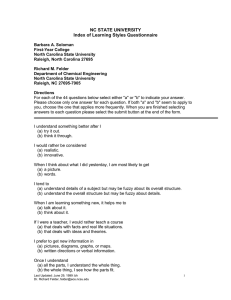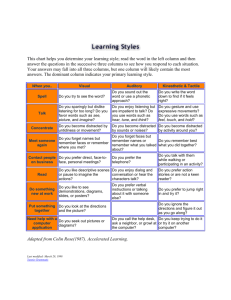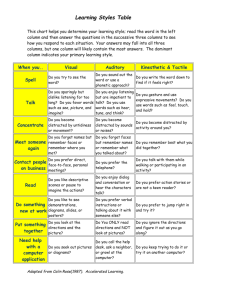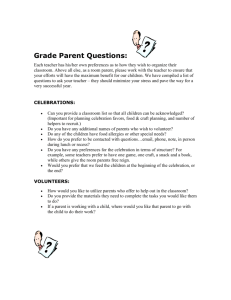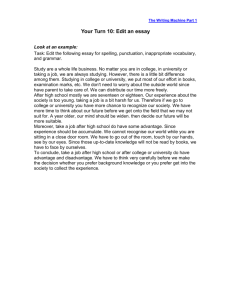Index of Learning Styles Questionnaire
advertisement
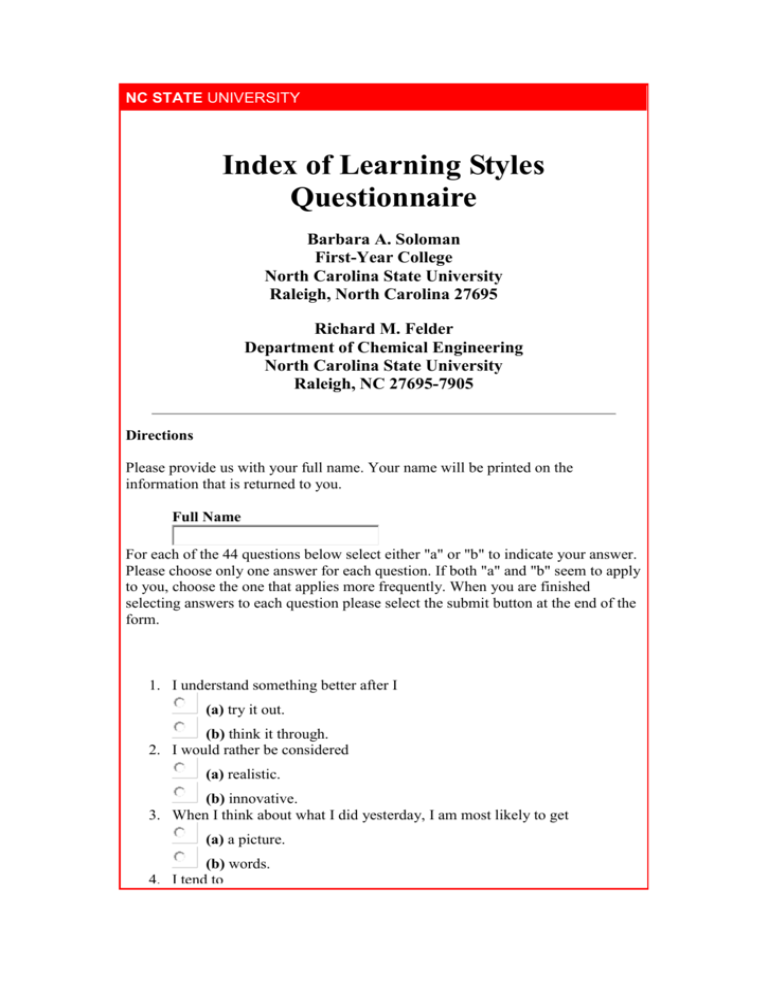
NC STATE UNIVERSITY Index of Learning Styles Questionnaire Barbara A. Soloman First-Year College North Carolina State University Raleigh, North Carolina 27695 Richard M. Felder Department of Chemical Engineering North Carolina State University Raleigh, NC 27695-7905 Directions Please provide us with your full name. Your name will be printed on the information that is returned to you. Full Name For each of the 44 questions below select either "a" or "b" to indicate your answer. Please choose only one answer for each question. If both "a" and "b" seem to apply to you, choose the one that applies more frequently. When you are finished selecting answers to each question please select the submit button at the end of the form. 1. I understand something better after I (a) try it out. (b) think it through. 2. I would rather be considered (a) realistic. (b) innovative. 3. When I think about what I did yesterday, I am most likely to get (a) a picture. (b) words. 4. I tend to (a) understand details of a subject but may be fuzzy about its overall structure. (b) understand the overall structure but may be fuzzy about details. 5. When I am learning something new, it helps me to (a) talk about it. (b) think about it. 6. If I were a teacher, I would rather teach a course (a) that deals with facts and real life situations. (b) that deals with ideas and theories. 7. I prefer to get new information in (a) pictures, diagrams, graphs, or maps. (b) written directions or verbal information. 8. Once I understand (a) all the parts, I understand the whole thing. (b) the whole thing, I see how the parts fit. 9. In a study group working on difficult material, I am more likely to (a) jump in and contribute ideas. (b) sit back and listen. 10. I find it easier (a) to learn facts. (b) to learn concepts. 11. In a book with lots of pictures and charts, I am likely to (a) look over the pictures and charts carefully. (b) focus on the written text. 12. When I solve math problems (a) I usually work my way to the solutions one step at a time. (b) I often just see the solutions but then have to struggle to figure out the steps to get to them. 13. In classes I have taken (a) I have usually gotten to know many of the students. (b) I have rarely gotten to know many of the students. 14. In reading nonfiction, I prefer (a) something that teaches me new facts or tells me how to do something. (b) something that gives me new ideas to think about. 15. I like teachers (a) who put a lot of diagrams on the board. (b) who spend a lot of time explaining. 16. When I'm analyzing a story or a novel (a) I think of the incidents and try to put them together to figure out the themes. (b) I just know what the themes are when I finish reading and then I have to go back and find the incidents that demonstrate them. 17. When I start a homework problem, I am more likely to (a) start working on the solution immediately. (b) try to fully understand the problem first. 18. I prefer the idea of (a) certainty. (b) theory. 19. I remember best (a) what I see. (b) what I hear. 20. It is more important to me that an instructor (a) lay out the material in clear sequential steps. (b) give me an overall picture and relate the material to other subjects. 21. I prefer to study (a) in a study group. (b) alone. 22. I am more likely to be considered (a) careful about the details of my work. (b) creative about how to do my work. 23. When I get directions to a new place, I prefer (a) a map. (b) written instructions. 24. I learn (a) at a fairly regular pace. If I study hard, I'll "get it." (b) in fits and starts. I'll be totally confused and then suddenly it all "clicks." 25. I would rather first (a) try things out. (b) think about how I'm going to do it. 26. When I am reading for enjoyment, I like writers to (a) clearly say what they mean. (b) say things in creative, interesting ways. 27. When I see a diagram or sketch in class, I am most likely to remember (a) the picture. (b) what the instructor said about it. 28. When considering a body of information, I am more likely to (a) focus on details and miss the big picture. (b) try to understand the big picture before getting into the details. 29. I more easily remember (a) something I have done. (b) something I have thought a lot about. 30. When I have to perform a task, I prefer to (a) master one way of doing it. (b) come up with new ways of doing it. 31. When someone is showing me data, I prefer (a) charts or graphs. (b) text summarizing the results. 32. When writing a paper, I am more likely to (a) work on (think about or write) the beginning of the paper and progress forward. (b) work on (think about or write) different parts of the paper and then order them. 33. When I have to work on a group project, I first want to (a) have "group brainstorming" where everyone contributes ideas. (b) brainstorm individually and then come together as a group to compare ideas. 34. I consider it higher praise to call someone (a) sensible. (b) imaginative. 35. When I meet people at a party, I am more likely to remember (a) what they looked like. (b) what they said about themselves. 36. When I am learning a new subject, I prefer to (a) stay focused on that subject, learning as much about it as I can. (b) try to make connections between that subject and related subjects. 37. I am more likely to be considered (a) outgoing. (b) reserved. 38. I prefer courses that emphasize (a) concrete material (facts, data). (b) abstract material (concepts, theories). 39. For entertainment, I would rather (a) watch television. (b) read a book. 40. Some teachers start their lectures with an outline of what they will cover. Such outlines are (a) somewhat helpful to me. (b) very helpful to me. 41. The idea of doing homework in groups, with one grade for the entire group, (a) appeals to me. (b) does not appeal to me. 42. When I am doing long calculations, (a) I tend to repeat all my steps and check my work carefully. (b) I find checking my work tiresome and have to force myself to do it. 43. I tend to picture places I have been (a) easily and fairly accurately. (b) with difficulty and without much detail. 44. When solving problems in a group, I would be more likely to (a) think of the steps in the solution process. (b) think of possible consequences or applications of the solution in a wide range of areas. When you have completed filling out the above form please click on the Submit button below. Your results will be returned to you. If you are not satisified with your answers above please click on Reset to clear the form. Submit Reset Dr. Richard Felder, felder@ncsu.edu
